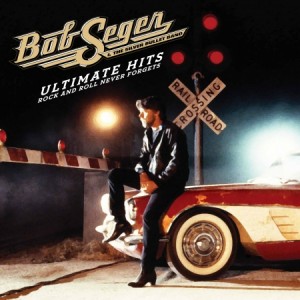Riffs, Rants & Rumors: Bob Seger's Still Making Night Moves
posted in: Features • Rock
 The Bob Seger catalog is the rock & roll equivalent of your skeletal system”you probably take it for granted to the point that you seldom think about it, but where would you be without it? In a crumpled, crippled heap on the floor, that’s where. Seger’s influence is so deeply embedded in American music that even some of his musical offspring might not realize it, as they’re inspired by artists who were in turn inspired by Seger himself, making for a kind of musical trickle-down theory. For instance, at least twenty-five percent of the current crop of male country artists owe their CMA awards to Seger’s heartland rock sound, even though they probably came of age soaking it up second-hand via John Mellencamp, et al.
The Bob Seger catalog is the rock & roll equivalent of your skeletal system”you probably take it for granted to the point that you seldom think about it, but where would you be without it? In a crumpled, crippled heap on the floor, that’s where. Seger’s influence is so deeply embedded in American music that even some of his musical offspring might not realize it, as they’re inspired by artists who were in turn inspired by Seger himself, making for a kind of musical trickle-down theory. For instance, at least twenty-five percent of the current crop of male country artists owe their CMA awards to Seger’s heartland rock sound, even though they probably came of age soaking it up second-hand via John Mellencamp, et al.
 Most people’s knowledge of Seger’s work extends about as far back as his 1976 breakthrough album, Night Moves, but the Detroit demon had already cut eight other albums before that, recording his first single while still in his teens back in 1961 and releasing his first record under his own name in ’68. He was turning out tough-minded, roots-rocking odes to the proles when Bruce Springsteen was still playing psychedelic guitar hero in Steel Mill, so even when most of the world came to know Seger for the first time some thirty-five years ago, he was already a well-traveled road dog. But after half a century in the business of rocking, sixty-six-year-old Seger seems to have no intention of settling into retirement.
Most people’s knowledge of Seger’s work extends about as far back as his 1976 breakthrough album, Night Moves, but the Detroit demon had already cut eight other albums before that, recording his first single while still in his teens back in 1961 and releasing his first record under his own name in ’68. He was turning out tough-minded, roots-rocking odes to the proles when Bruce Springsteen was still playing psychedelic guitar hero in Steel Mill, so even when most of the world came to know Seger for the first time some thirty-five years ago, he was already a well-traveled road dog. But after half a century in the business of rocking, sixty-six-year-old Seger seems to have no intention of settling into retirement.
Seger hit the road earlier this year with his tireless troupe of heavy-duty henchmen, The Silver Bullet Band, for a tour that seemed to get longer and longer, as more and more fans created a seemingly undeniable demand for an audience with the classic-rock king. As it stands, Seger and company are set to spend the rest of 2011 traipsing across the nation to bring their brand of searing, soulful American music to the masses, not stopping until they bump up against the new year at their December 30 Las Vegas concert.
Crucially, the double-disc anthology Ultimate Hits: Rock and Roll Never Forgets has just been released, and Seger’s seminal live albums, Live Bullet and Nine Tonight, were recently reissued, reminding us all of the riches to be found in the man’s canon and of the sweat, soul, and sonic sanctification that are a part of the live Seger experience. Ultimate Hits handily offers up a comprehensive guide to the rock journeyman’s career highlights, from early, R&B-inflected tracks like “Ramblin’ Gamblin’ Man” to later, country-tinged tunes like “Fire Lake” and “Shame On The Moon,” but the live albums really flesh out the Seger story. Originally released in 1976, Live Bullet was recorded in ’75, before Night Moves eventuated Seger’s national breakout, but his hometown audience was big enough to pack Detroit’s storied concert venue Cobo Hall. His hyperkinetic versions of Tina Turner‘s Nutbush City Limits, Van Morrison‘s I’ve Been Working and Bo Diddley‘s eponymous signature song showed how close Seger still was to his roots, but new songs Beautiful Loser and Travelin’ Man pointed towards more of a contemplative singer/songwriter direction.
 Five years later, Seger and his band were captured in concert at Cobo (and Boston Garden) again for Nine Tonight. Night Moves had already spent four years burning itself indelibly into the public consciousness, but its songs still felt fresh. Today Rock and Roll Never Forgets may have become ubiquitous everywhere from classic-rock radio playlists to wedding-band set lists, but even in 1980, rock was still considered largely a youth-culture phenomenon; an anthem about rocking your way towards middle age was still a fairly radical thing, and the idea was well earned”it was no coincidence that Seger himself was a year into his thirties when he wrote about how sweet sixteen’s turned 31. And when sociopolitical motivations in the rock mainstream had long since been buried with the paisley-patterned corpse of the hippie movement, The Fire Down Below offered a concise articulation of class-consciousness from the ground up. Plus, as hard as it may be to believe now, there was a time when wistful nostalgia for one’s teenage sexual awakening, accompanied by poignant piano chords (Night Moves), was not yet a cliché. If anything, Seger was just hitting his stride as a songwriter”most of his peers would have happily sacrificed their summer homes in the Hamptons for lines as potent as Wish I didn’t know now what I didn’t know then, from the title track of 1980’s Against the Wind.
Five years later, Seger and his band were captured in concert at Cobo (and Boston Garden) again for Nine Tonight. Night Moves had already spent four years burning itself indelibly into the public consciousness, but its songs still felt fresh. Today Rock and Roll Never Forgets may have become ubiquitous everywhere from classic-rock radio playlists to wedding-band set lists, but even in 1980, rock was still considered largely a youth-culture phenomenon; an anthem about rocking your way towards middle age was still a fairly radical thing, and the idea was well earned”it was no coincidence that Seger himself was a year into his thirties when he wrote about how sweet sixteen’s turned 31. And when sociopolitical motivations in the rock mainstream had long since been buried with the paisley-patterned corpse of the hippie movement, The Fire Down Below offered a concise articulation of class-consciousness from the ground up. Plus, as hard as it may be to believe now, there was a time when wistful nostalgia for one’s teenage sexual awakening, accompanied by poignant piano chords (Night Moves), was not yet a cliché. If anything, Seger was just hitting his stride as a songwriter”most of his peers would have happily sacrificed their summer homes in the Hamptons for lines as potent as Wish I didn’t know now what I didn’t know then, from the title track of 1980’s Against the Wind.
These days, Seger’s studio releases are few and far between”he’s said to be working on a new album for 2012 release, which would only be his second in the last seventeen years. But a quick glance at his itinerary shows that he’s got no qualms about keeping his show on the road, so who knows? Maybe he’s got one more classic live album left in him, and maybe it’ll be recorded on this tour; turn up on the right night and scream loud enough, and you just might make yourself a part of rock & roll history. Hell, live album or no, a Seger show’s still got to be considered something of a historic occurrence.
